
Original Link: https://www.anandtech.com/show/2314
Gigabyte GA-X38-DQ6: An early look at X38
by Gary Key on September 4, 2007 3:00 AM EST- Posted in
- Motherboards
Intel has certainly been on a roll for the past year, and from all indications there's a good chance this will continue for the foreseeable future. Even though they are looking down the barrel of AMD's K10 gun, with Barcelona scheduled to launch next week and Phenom later this year, they are continuing to release product at a brisk pace and seem unfazed by what their competitors are planning. It is this focus that has brought us the Core 2 processor family and a string of new chipsets since June of 2006.
Instead of taking a breather or resting on its laurels, we will see several new chipsets and processor families over the course of the upcoming year as Intel continues to march to the beat of a company looking to annihilate everyone and everything in its way. While you can debate the merits of their product lineup, potential performance improvements, costs, or what it all really means for the consumer, you cannot deny their tenacity in trying to address just about every sector of the market they serve with a class leading product.
One of those market sectors consists of a very loyal and very vocal group: the computer enthusiasts whose lust for the latest and greatest technology often drives the market to innovate at a pace faster than it normally would. The next chipset on Intel's product road map is designed specifically for this group, but it should also find its way into the workstation market in a short time.
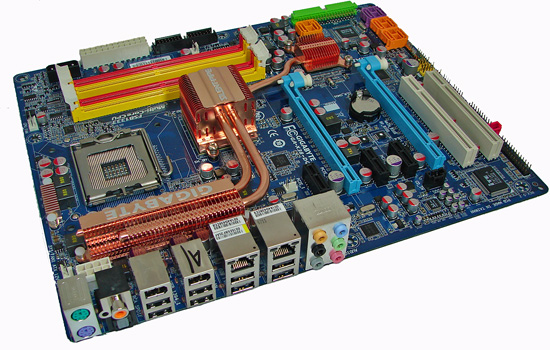
Intel designed the P35 with the mainstream market in mind and always planned on the X38 being the chipset that would offer the next step in performance, whether that was in a multi-GPU situation with dual x16 capability and enhanced throughput, improved memory/chipset performance, or as a great overclocking platform for a wide range of Core 2 processors including the upcoming Penryn series.
We will go into detail about the X38, its range of capabilities, and design aspects when the chipset officially launches on September 24th, but for now we will provide a very early look at its performance with the Gigabyte GA-X38-DQ6. In fact, this preview is based on an engineering sample board and BIOS, but we felt like the progress of the X38 chipset on this particular board warranted a sneak peek of its performance capability - or in this case more like its potential.
Our testing today is centered on a select group of synthetic and application benchmarks that will provide a general indication of how the X38 currently performs with beta hardware. We will follow up shortly with results from a retail board/BIOS combination that will focus on CrossFire (sorry, as of now there's no official SLI support), overclocking, power consumption, and additional application benchmarks.
Let's take a quick look at the performance of the Gigabyte GA-X38-DQ6 against one of the better P35 boards on the market today.
Test Setup
| Gigabyte GA-X38-DQ6 / abit IP-35 Pro Testbed | |
| Processor | Intel Core 2 Quad Q6600 Quad Core, 2.4GHz, 2x4MB Unified Cache, 9x266 1066FSB |
| CPU Voltage | 1.2V |
| Cooling | Tuniq Tower 120 |
| Power Supply | Cooler Master Real Power Pro 1000W |
| Memory | OCZ Flex PC2-9600 (4x1GB) |
| Memory Settings | 4-4-4-12 (1066, 2.25V), 5-5-5-18 (1200 2.30V) |
| Video Cards | MSI 8800GTX |
| Video Drivers | NVIDIA 163.44 |
| Hard Drive | Seagate DB35.3 7200RPM 750GB SATA 3/Gbps 16MB Buffer |
| Optical Drives | Plextor PX-B900A, Toshiba SD-H802A |
| Audio Card | ASUS Xonar D2 |
| Audio Drivers | ASUS 5.12.01.0008.17.19 |
| Case | Cooler Master Stacker 830 Evo |
| BIOS | Gigabyte D19 (engineering BIOS), abit M629B12.B02 |
| Operating System | Windows Vista Home Premium 32-bit |
| . | |
Test conditions were maintained the same, as much as possible, over the platforms tested. Our game tests were run at settings of 1280x1024 HQ to ensure our MSI 8800GTX is not the bottleneck during testing. We utilized our MTRON MSD-S25032 32GB solid state drive for our PCMark05 and media encoding tests as we are trying to isolate any differences between the chipsets. All results are reported in our charts and color-coded for easier identification of results.
We selected the Intel Core 2 Quad Q6600 as our processor of choice since it represents one of the better price to performance values in the midrange processor market, and it is also the CPU we will focus on in future reviews. We are utilizing Microsoft Vista Home Premium 32-bit as our operating system along with a 4GB memory configuration. Even though Vista 32-bit cannot take advantage of the entire 4GB of memory address space (3.326GB), we found the additional 1.278GB of memory available provided improved performance during multitasking events and gaming. We would not recommend anything less than 2GB with Vista Home Premium. We will also provide select Vista 64-bit results in our full review.
We utilize new drive images on each board in order to minimize any potential driver conflicts. Our 3DMark results are generated utilizing the standard benchmark resolution for each program. We run each benchmark five times, throw out the two low and high scores, and report the remaining score. All results at stock speeds for this article are with memory timings at 4-4-4-12 (DDR2-1066) and at 5-5-5-18 (DDR2-1200) for our overclocking tests. Where possible, memory sub-timings were set exactly the same to ensure consistency between the two chipsets.
Our choice of software applications to test is based on programs that enjoy widespread use and produce repeatable and consistent results during testing. Microsoft Vista has thrown a monkey wrench into testing as the aggressive nature of the operating system to constantly optimize application loading and retrieval from memory or the storage system presents some interesting obstacles. This along with the lack of driver maturity or features will continue to present problems in the near future with benchmark selections.
Our normal process is to change our power settings to performance, delete the contents of the prefetch folder, and then reboot after each benchmark run. This is a lengthy process, but it results in consistency over the course of benchmark testing. All applications are run with administer privileges.
Memory Testing
 |
| Click to enlarge |
The Sandra unbuffered scores on the Gigabyte board are around 4% better at stock speeds and 7% better in our overclocked scenario. In our SuperPI 1.5 benchmark that relies on low latencies for improved scores, we see where this advantage is apparent. We consider these results to be excellent as the X38 chipset, BIOS, and board are engineering samples and we fully expect to see further improvements in the retail boards.
Q6600 9x266 Memory Tests
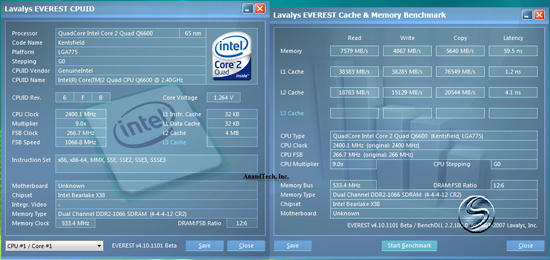 |
| Click to enlarge |
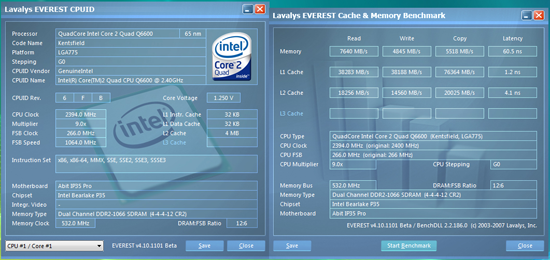 |
| Click to enlarge |
We were able to set our timings to 4-4-4-12 at DDR2-1066 by increasing the memory voltage to 2.250V on the Gigabyte board and 2.275V on the abit board. In this particular test, our two boards are basically equal with write, latency, and copy tests favoring the X38 and read throughput going to the P35.
Q6600 9x400 Memory Tests
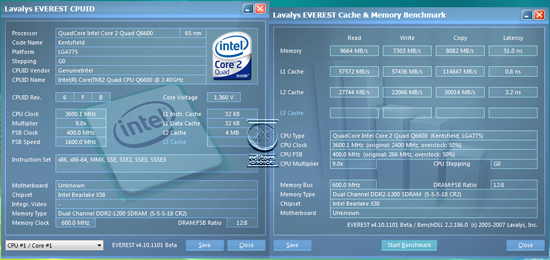 |
| Click to enlarge |
 |
| Click to enlarge |
Like our stock scores, the two boards are basically equal with write, latency, and copy tests favoring the X38 and read throughput going to the P35. We set our memory timings to 5-5-5-18, bumped the memory voltages up to 2.275V and 2.350V, and equalized the memory sub-timings where applicable.
Synthetic Graphics Performance
The 3DMark series of benchmarks developed and provided by Futuremark are among the most widely used tools for benchmark reporting and comparisons. Although the benchmarks are very useful for providing apple to apple comparisons across a broad array of GPU and CPU configurations they are not a substitute for actual application and gaming benchmarks. In this sense we consider the 3DMark benchmarks to be purely synthetic in nature but still valuable for providing consistent measurements of performance.
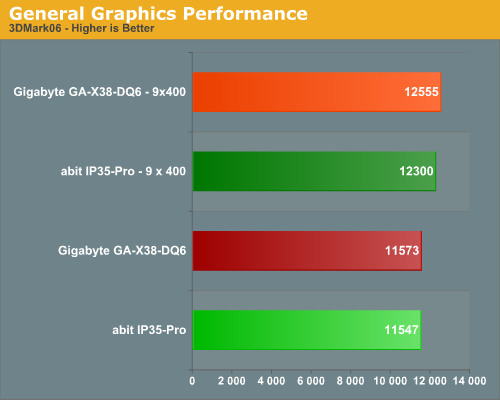
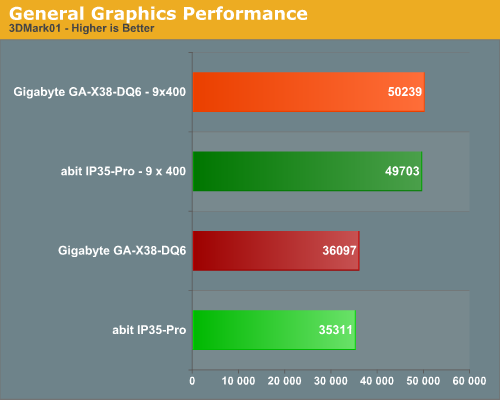
In our 3DMark06 test, the X38 and P35 are basically even in this test. The Gigabyte board is around 2% faster when overclocked although this margin is still relatively small. When looking at the individual tests, the Gigabyte board scored slightly better in the SM2.0 and SM3.0 tests while the CPU scores were just about identical when comparing the two chipsets.
In the more memory and CPU throughput sensitive 3DMark01 benchmark we see our Gigabyte GA-X38-DQ6 board about 2% quicker at stock speeds and only 1% when overclocked. The differences in performance are not really noticeable in either 3DMark unless you're looking to reach the top of the ORB, which we have a good feeling the X38 was designed to do with the right setup.
General System Performance
The PCMark05 benchmark developed and provided by Futuremark is designed to measure overall system performance for the typical home computing user. This tool provides both system and component level benchmarking results utilizing subsets of real world applications or programs. This benchmark is useful for providing comparative results across a broad array of Graphics, CPU, Hard Disk, and Memory configurations along with multithreading results. In this sense we consider the PCMark benchmark to be both synthetic and real world in nature and it again provides consistency in our benchmark results.
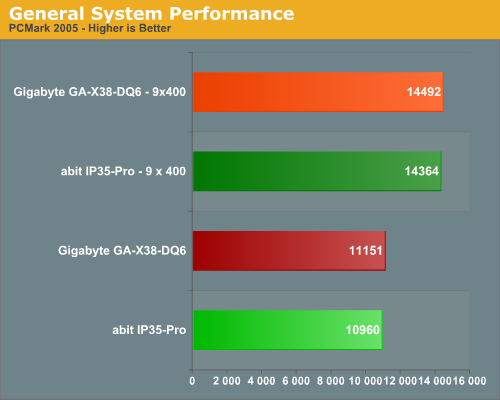
Our PCMark05 scores mimic the results from our 3DMark benchmarks with differences of around 2% at stock speeds and 1% when overclocked. While this benchmark is designed around actual application usage, we will see if these results mirror our own real-world application testing.
Media Encoding Performance
We are utilizing Nero Recode 2 and Sony Vegas 7.0e for our video encoding tests. The scores reported include the full encoding process and are represented in seconds, with lower numbers indicating better performance.
Our first series of tests is quite easy - we take our original Office Space DVD and use AnyDVD to rip the full DVD to the hard drive without compression, thus providing an almost exact duplicate of the DVD. We then fire up Nero Recode 2, select our Office Space copy on the hard drive, and perform a shrink operation to allow the entire movie along with extras to fit on a single 4.5GB DVD disc. We leave all options on their defaults except we uncheck the advanced analysis option.
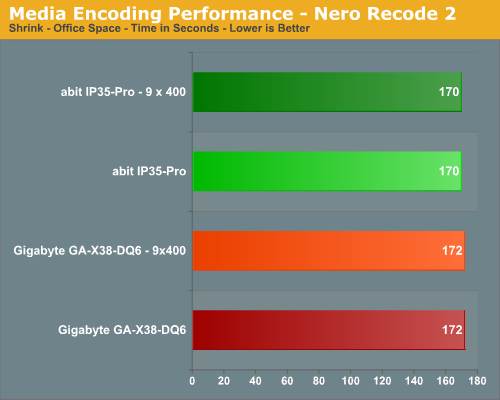
We find in this CPU and disk intensive test that both boards score equally, which is not surprising since both boards utilize the same ICH9R Southbridge and considering the early nature of Gigabyte board.
Our Sony Vegas 7.0e test converts several of our summer vacation files into one plasma screen pleasing 1080/24P format with a 5.1 audio stream. We ensure our quality settings are set to their highest levels and then let the horses loose.
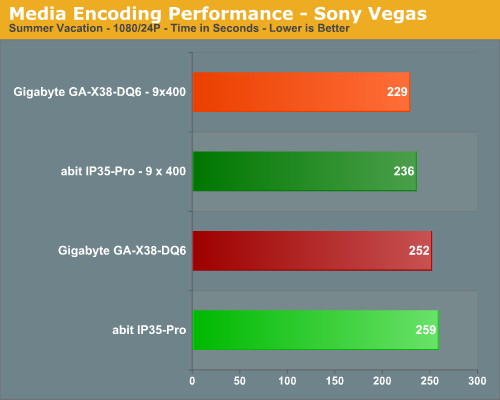
In a test that really stresses the CPU and memory subsystem, we see the Gigabyte board is about 3% faster at stock and overclocked speeds than the abit board.
File Compression Performance
In order to save space on our hard drives and provide another CPU crunching utility, we utilize WinRAR 3.70 to perform some compression tests. WinRAR now fully supports multithreaded operations and should be of particular interest for those users with dual core or multi-processor systems. Our test folder contains 444 files, ten subfolders, and 602MB worth of data. All default settings are utilized in WinRAR and our hard drive is defragmented before each test.
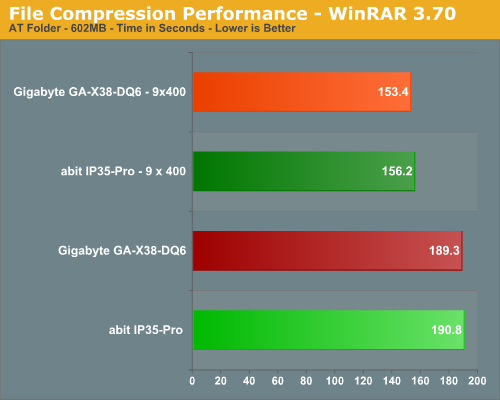
Once again we see the early X38 engineering sample from Gigabyte performing well in a test that stresses overall memory latencies and CPU/Memory throughput. However, this is one of our application benchmarks where we thought the X38 would perform measurably better against the P35. The nature of file compression is such that memory is accessed almost constantly in a very random fashion, so page misses requiring additional time as memory banks are swapped is common. The Gigabyte board is 2% quicker at stock and about 1% faster when overclocked than the abit board. This indicates slightly better memory/CPU throughput capabilities, but it's not at the level we expected - at least not yet.
Rendering Performance
We are using the Cinebench 10 benchmark as it tends to heavily stress the CPU subsystem while performing graphics modeling and rendering. Cinebench 10 features two different benchmarks with one test utilizing a single core and the second test showcasing the power of multiple cores in rendering the benchmark image. We utilize the standard multi-core benchmark and default settings.
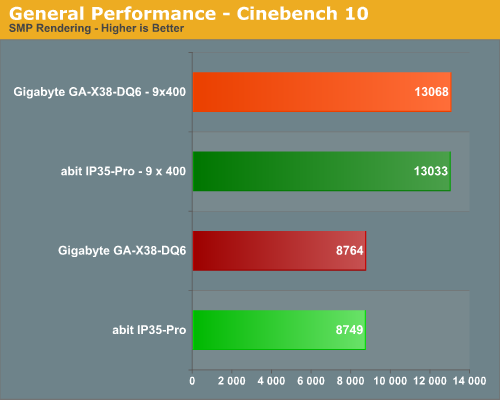
Once again we see the X38 equipped board finishing ahead of the P35 board, although the differences are less than a percent.
Gaming Performance
As usual, gaming performance was tested with a variety of current games. We ran our benchmarks at a 1280x1024 resolution with high quality settings
Battlefield 2
This benchmark is performed using DICE's built-in demo playback functionality with additional capture capabilities designed in house. During the benchmark, the camera switches between players and vehicles in order to capture the most action possible. There is a significant amount of smoke, explosions, and vehicle usage as this a very GPU intensive Battlefield 2 benchmark. We run Battlefield 2 using medium quality graphics settings available in the video settings. The game itself is best experienced with average in-game frame rates of 35 and up.
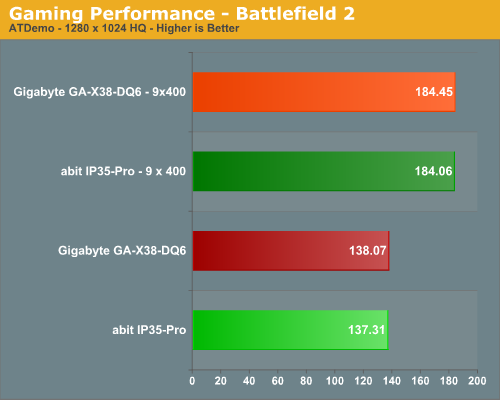
Half Life 2: Episode One
We use the built-in timedemo feature to benchmark the game. Our timedemo consists of starting at the bottom of the hill near the lake and ending in the old church. The Source engine timedemo feature is similar to the nettimedemo of Id's Doom 3 engine, in that it plays back more than just the graphics. The visual quality settings were set to high or medium where possible with HDR off. While the Source engine is notorious for giving great frame rates for almost any hardware setup, we find the game isn't as enjoyable if it isn't running at 30fps or above.
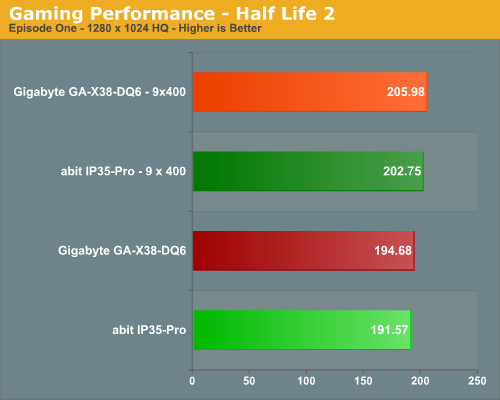
Prey
Prey offers some superb action sequences, unique weapons and characters, and is a visually stunning game at times. It still requires a very good GPU to run it with all of the eye candy turned on. We set all graphic settings to their maximum except for AA/AF and utilize a custom timedemo that takes place during one of the more action oriented sequences. We generally find the game to be enjoyable with an average frame rate above 35fps.
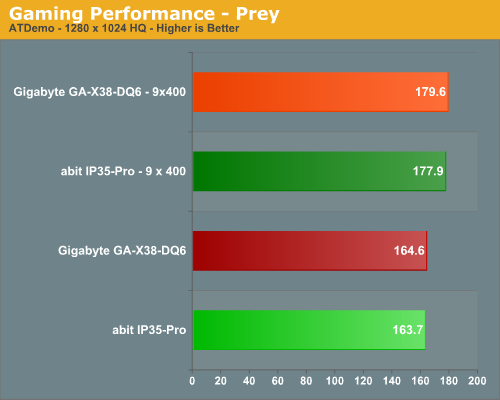
Supreme Commander
Supreme Commander is one of the favorite real time strategy games around the office as it continues to provide a great deal of replay value and the graphics are very good once the eye candy is turned on. What we especially like about the game is the fact that it can bring the best system to its knees and that fact makes it a great system benchmark. This particular game requires both a very good CPU and GPU when playing the game at anything above 1024x768 with decent settings. We utilize the game's built-in benchmark and generally find the game to be enjoyable with an average frame rate above 25fps.
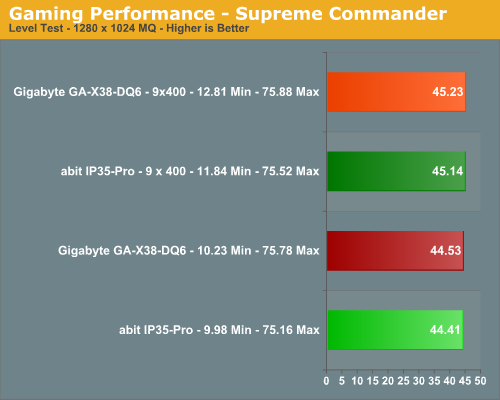
Gaming Summary
Although the X38 board consistently finishes first in all of our benchmarks, the differences only average around 1% to 2% at this time. We fully expect the retail level boards to improve upon these scores by a couple of percent, but the net result is that GPU choice will still be a much bigger consideration than the motherboard chipset. Once we receive the shipping BIOS and retail board, we will revisit these same games and provide CrossFire results against the P35 and 975X equipped boards.
First Thoughts
It is hard to find any faults with the X38 chipset at this time. Even though we are working with an engineering sample that has been around the block a few times and an early engineering BIOS that is designed more for debugging the chipset than providing top performance, it still manages to outperform a fairly mature P35 equipped motherboard that offers excellent performance in its own right.
We are generally impressed with the Gigabyte GA-X38-DQ6 motherboard and look forward to providing updated results with our retail board once the release BIOS arrives in the lab. Even in its early state, the performance is very good and stability has been excellent throughout several days of 24/7 benchmark testing. In fact, we found the stability, performance, and compatibility of this early engineering sample to be better than several retail boards we are currently testing.
Although in early testing it appears the power consumption of this board is up to 18W higher than a similarly equipped GA-P35-DQ6 board, we did not find the increased thermal loads creating any issues during testing. With the added number of PCI-E lanes and the same process technology, we didn't really expect a decrease in power requirements, though it would have been nice to get that as well. We will provide full thermal and power consumption numbers shortly, but we can say without a doubt that the X38 MCH will bring a new meaning to the word "heat" when overclocking.
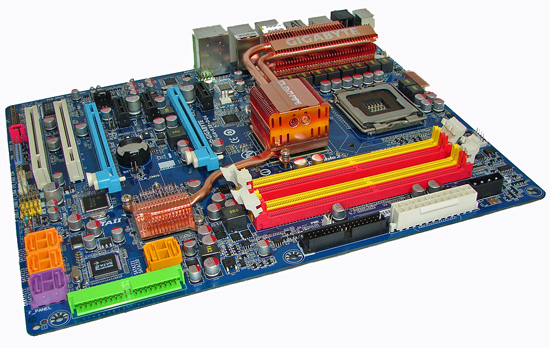
Speaking of overclocking, in testing to date with the engineering sample, we were able to match or exceed the levels reached with our best P35 motherboards when utilizing the quad core processors. We even managed several benchmark runs at 510FSB with our Q6600 set at an 8x multiplier and additional cooling. Also of note, at least with this particular board setup, we generally could run our CPU and memory voltages slightly lower at the same settings as our P35 boards. Dual core performance with a wide variety of chips was excellent also, but we will reserve final judgment of the capabilities of the chipset and board until we have a production release BIOS and additional retail boards. For now, we look forward to providing those results in the near future.
Despite being faster than the Intel P35 in our limited test suite, the percentages were minor to say the least. Expecting a large performance leap in stock performance is generally unrealistic with a new chipset release. The most promising results are in our Sandra unbuffered, MemTest, and SuperPI 1.5 results where we can see the strength of this chipset. It is still difficult to determine exactly what the performance improvements will be over the P35 chipset, but for now most of the motherboard suppliers think an average of 3% to 5% is the correct range and it should only improve as the BIOS matures. This does not take into account the projected improvements in overclocking or CrossFire performance, areas that the X38 is supposedly designed to excel in with the right components.
In the early stages, it certainly appears that Intel has another great enthusiast chipset on its hands and a worthy successor to the 975X. Of course, only time and retail boards will prove us right or wrong, but our early guesstimates indicate this chipset should have a long life... well, at least until Nehalem appears but that is a story for another time.







